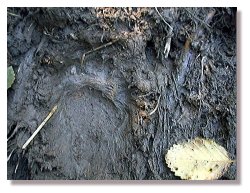Tracking the
Wildlife
By Damien Barstead
The Haig-Brown Kingfisher Creek Restoration Project is undeniably centred around
providing new and enhanced wild habitat for the coho and trout of the system. While enhancing
and creating this habitat is highly valuable, and a noble gesture towards helping the local
wildlife, one must not forget to consider the needs of other types of wildlife that may use the
Haig-Brown Kingfisher Creek system.
Even during the current construction phase of the project, there has been evidence
that a variety of animals have been inhabiting the Haig-Brown Heritage Properties. As a result,
the animals’ well-being must be a consideration in the future plans for the properties.
Historically, the animals that lived on and around the Haig-Brown Greenways Property ranged
from larger predators such as cougars, and black bears, to other mammals such as island
blacktailed deer, minks, racoons, and shrews. As well, the varied tree species on the property
offer habitat to dozens of bird species. Red winged blackbirds, red breasted robins, swainsons
thrushes, banded kingfishers, and golden merganzers are just a few of the bird species you're
liable to see in the area.
|
Just down one of the newly dug fish access points, which leads into one of the thick
skunk cabbage wetlands, the restoration project’s staff have been noticing fresh animal tracks
in the mud.

Deer and bear tracks are illustrative of
the full range of
wildlife that takes
advantage of the Haig-Brown property.
One particular morning, sets of deer and bear tracks were found side by side. Upon closer
inspection, it was noticed that a bear had entered the work-site from a connecting animal trail
and mulled about in the wetland. Nearby, a large hole in the skunk cabbage was spotted that
contained several crushed plants, skunk cabbage stalks, and half-eaten leaves. These remnants
are examples of distinct damage and foraging marks that show where the bear most likely had an
early-morning snack.
This is just one example of the types of animals that are currently benefiting from the
preservation of these lands. It is everyone’s hope that the addition of large amounts of salmon
habitat to the already existing sanctuary will be a positive contribution to the existing array of
natural wildlife in the park.
Top of page.
|

